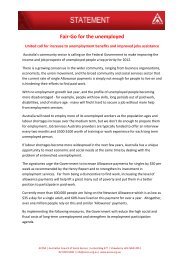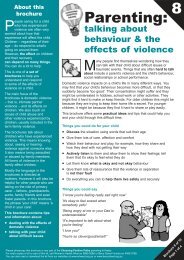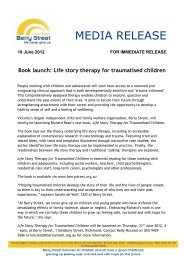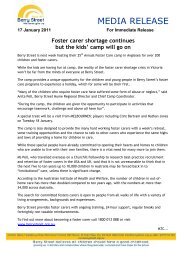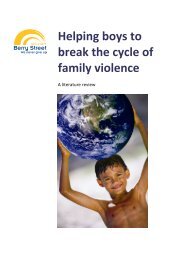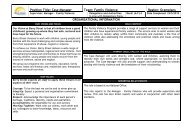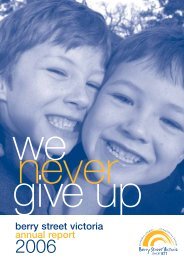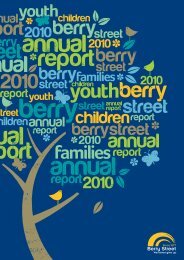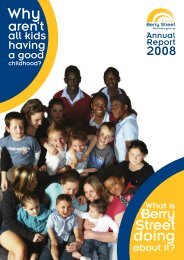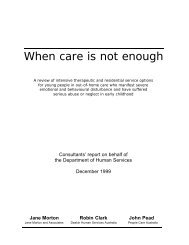Take Two - Third Evaluation Report More than Words ... - Berry Street
Take Two - Third Evaluation Report More than Words ... - Berry Street
Take Two - Third Evaluation Report More than Words ... - Berry Street
Create successful ePaper yourself
Turn your PDF publications into a flip-book with our unique Google optimized e-Paper software.
and Therapeutic Residential Care are usually located<br />
in <strong>Take</strong> <strong>Two</strong> sites and with the partner organisation,<br />
including Secure Welfare and Hurstbridge Farm.<br />
Material resources and equipment<br />
As <strong>Take</strong> <strong>Two</strong> is not a case management service it does<br />
not provide material resources to the client group, but<br />
may engage with other services for these needs to be<br />
met. The equipment needed to do the work can be<br />
categorised into functional, therapeutic, research and<br />
training equipment.<br />
Functional equipment used by <strong>Take</strong> <strong>Two</strong> supports the<br />
day-to-day service, such as all clinical staff having access<br />
to vehicles, computers, other of ce equipment and<br />
mobile phones. Another type of functional equipment<br />
is the documents used by clinical staff for recording<br />
case notes, assessment reports and other recording.<br />
The <strong>Take</strong> <strong>Two</strong> Client Information System (T2-CIS) will<br />
be an important aspect of functional equipment once in<br />
operation and even in its early stages has contributed<br />
to the service’s ability to accept referrals.<br />
Research equipment used by <strong>Take</strong> <strong>Two</strong> includes<br />
statistical and other software (such as SPSS and<br />
Endnote), and access to extensive library data bases<br />
and libraries through the partner organisations of La<br />
Trobe University and Mindful. Although these are<br />
primarily used by the teams in the knowledge area,<br />
all <strong>Take</strong> <strong>Two</strong> staff have access to the Mindful library.<br />
Training equipment includes DVDs, other audiovisual<br />
equipment, training activity sheets, feedback sheets<br />
and physical resources, such as training kits that assist<br />
in transporting training materials from one workshop to<br />
the next.<br />
Therapeutic equipment includes toys, games and<br />
other play equipment used in therapy, clinical outcome<br />
measures (some of which need to be regularly<br />
purchased), and activities that can be used with clients.<br />
3.6 Therapeutic care<br />
The When Care is not Enough report (Morton et al.,<br />
1999) identi ed a need to work therapeutically with<br />
children in the care system. As noted earlier, this report<br />
recommended a number of therapeutic care initiatives.<br />
When <strong>Take</strong> <strong>Two</strong> was rst established, a recognised<br />
need was to provide a senior clinical role within the<br />
DHS Secure Welfare Service. In effect, this was <strong>Take</strong><br />
<strong>Two</strong>’s rst therapeutic specialist, although not named<br />
as such at the time. <strong>Take</strong> <strong>Two</strong> also quickly realised that<br />
much of its work in the regional and Aboriginal teams<br />
was working directly with the foster parents, kinship<br />
carers, residential care staff and parents. <strong>Take</strong> <strong>Two</strong><br />
contributed substantially to the DHS-led policy and<br />
program development regarding therapeutic foster care<br />
and therapeutic residential care. Each of the following<br />
initiatives has built on the work undertaken within the<br />
broader sector but also with the work of <strong>Take</strong> <strong>Two</strong> in<br />
Secure Welfare and the regional clinical teams.<br />
The recommendations by Morton and colleagues (1999)<br />
regarding therapeutic care, though not initially funded,<br />
have subsequently begun to be funded by DHS and<br />
implemented across the state. Many, but not all of the<br />
therapeutic care initiatives, involve <strong>Take</strong> <strong>Two</strong> as the<br />
therapeutic specialist in partnership with care providers.<br />
20<br />
3.6.1 The Circle Program<br />
Implemented in mid 2007, the Circle Program — a<br />
therapeutic approach to foster care — was introduced<br />
to better meet the needs of children in foster care.<br />
The Circle Program is part of the strategic aim of the<br />
government to build a system of home-based care<br />
where all children receive the therapeutic response<br />
they require when they require it and to develop “a<br />
therapeutic system not just a therapeutic model”<br />
(Department of Human Services, 2009b, 6). The<br />
Circle Program model endeavours to give effect to the<br />
principles contained in the Children, Youth and Families<br />
Act 2005 and the Child Wellbeing and Safety Act 2005<br />
with the core principle of the best interests of the child.<br />
The Circle Program has a set of articulated principles and<br />
conceptual framework. The conceptual framework has<br />
four interacting components: the child is at the centre<br />
of the program; the care team to facilitate the ability of<br />
all those in the care environment to effectively support<br />
the child to recover from the effects of trauma; the<br />
care environment including the microsystems of home,<br />
family, school and networks; and the engagement<br />
of the child at all stages. A goal of the program is to<br />
promote timely reuni cation between the children and<br />
family or alternative long-term stable care (Department<br />
of Human Services, 2009b).<br />
The Circle Program was implemented through<br />
partnerships of CSOs and therapeutic services. <strong>Take</strong><br />
<strong>Two</strong> tendered successfully within these partnerships in<br />
four regions as the therapeutic specialist of the team<br />
with CSOs as the lead agency. The detailed guidelines<br />
for implementation ensure consistency of approach.<br />
The outcome measures for children utilised in the Circle<br />
Program include four which are utilised in the <strong>Take</strong><br />
<strong>Two</strong> outcome framework, hence <strong>Take</strong> <strong>Two</strong> workers are<br />
experienced in their administration.<br />
<strong>Take</strong> <strong>Two</strong> therapeutic specialists are members of<br />
care teams in the Circle Program. As the therapeutic<br />
specialist, <strong>Take</strong> <strong>Two</strong> has speci c roles which include<br />
face to face contact with the carer at least weekly and<br />
to take the lead in the assessment of the child and<br />
development and monitoring of individual therapeutic<br />
care plans. <strong>Take</strong> <strong>Two</strong> with the CSO also engages in<br />
the assessment of therapeutic foster carers following<br />
training. The process of recruitment, assessment,<br />
training and accreditation of carers is key to the Circle<br />
Program and is actively shared between <strong>Take</strong> <strong>Two</strong> and<br />
the placement agency.<br />
The Circle Program is another <strong>Take</strong> <strong>Two</strong> activity which<br />
engages and provides opportunity to build upon the<br />
relationship between <strong>Take</strong> <strong>Two</strong> and child protection and<br />
the broader care system for the bene t of the child.<br />
3.6.2 Hurstbridge Farm<br />
The concept of applying trauma and attachment theory<br />
to interventions with children who have been abused<br />
has also informed the development of Hurstbridge Farm<br />
which was initiated by DHS in mid 2007 (Holmes, 2007).<br />
In 2004 DHS Eastern Metropolitan region and North<br />
and Western Metropolitan region with the support of<br />
the DHS Central Child Protection and Family Services<br />
Branch purchased a 33-acre property in Hurstbridge<br />
(outer northern suburb of Melbourne) to establish a<br />
therapeutic model of care for young people 12—14.9<br />
years of age. The aim of Hurstbridge Farm is to make<br />
a difference in the lives of young adolescents who<br />
Frederico, Jackson, & Black (2010) “<strong>More</strong> <strong>than</strong> <strong>Words</strong>” – <strong>Take</strong> <strong>Two</strong> <strong>Third</strong> <strong>Evaluation</strong> <strong>Report</strong>, La Trobe University, Bundoora, Australia



